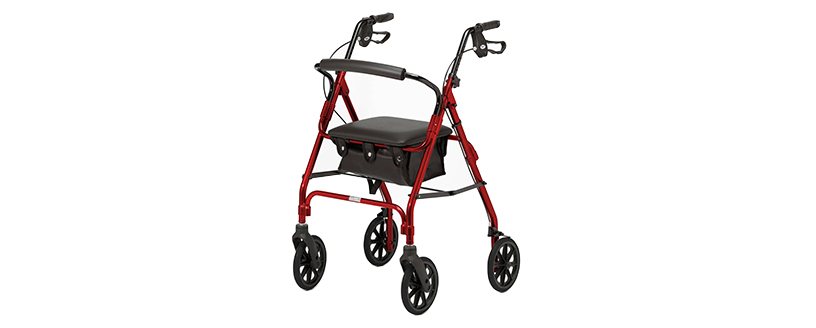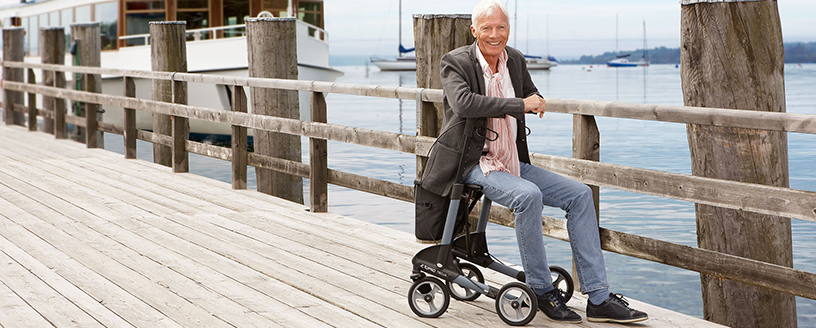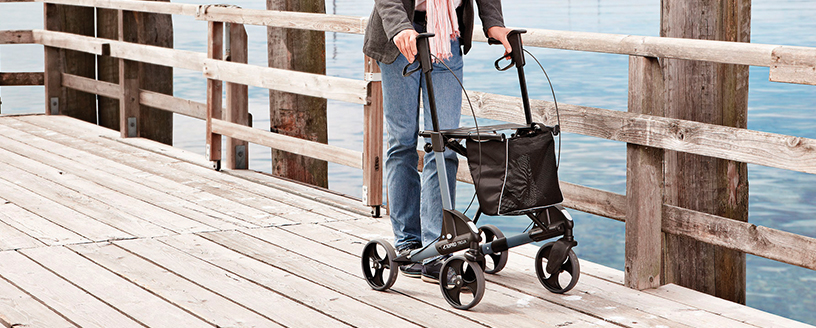What Is A Rollator With Seat?
A rollator with seat is a terrific piece of equipment that is designed to be used by people with mobility issues, which often includes the elderly or people with disabilities. Rollators provide the users with the means to move around on their own, maintaining their independence for longer.
Sometimes referred to as a walker with wheels, a rollator consists of a frame with three or four wheels and two handlebars. Some models also feature a seat and a backrest which allow the user to stop and rest as and when necessary.
Additional accessories can also be added to a rollator for greater comfort or added convenience, such as a bag or basket to hold items when shopping. Some can even accommodate holders for cups, water bottles, or canes. You can find a variety of these mobility aids right here at Clearwell Mobility.
This type of equipment can be manoeuvred more easily for walking longer distances because of its wheels. These wheels greatly assist the user by reducing the amount of effort they need to exert in order to move forwards. Rollators also come in lightweight and folding variants, making them more convenient to carry around or transport by car when necessary.
The first rollators were designed in 1978 by Aina Wifalk, a Swedish nurse turned social scientist and inventor who had polio. In 2011, a variation of Wifalk’s wheeled walker from Norway was awarded the Red Dot Design Award in the Life Science and Medicine category. Today, the term rollator is used to refer to all walkers with wheels, and they have become an increasingly popular type of mobility aid in recent years.

When is a rollator best used?
When walking with a traditional walker, the user needs to be able to lift the unit up and put it back down in order to move forwards. This requires a degree of arm strength and the ability to grip tightly on the equipment to move it from one place to another.
Walkers without wheels are best if the user requires something heavy to lean on before every step. The walker’s legs will stay sturdy and stable on the ground to provide the support needed. In cases where the user is unable to maintain weight on both or either of their legs, the traditional walker is also often the better choice.
Rollators, on the other hand, are best for people who can walk but need assistance in balancing themselves while doing so. They are very useful for people with medical conditions that cause them to tire quickly or need rest more frequently, like people with heart problems, for example. If you have weak arms or less upper body strength than you used to have, a rollator is also the better choice.
Differences Between Rollators In The UK
There are a variety of rollators designed to support different needs. You can check out Clearwell Mobility if you would like to see the available options and decide which is the most suitable for your own requirements.
Some of the features you’re looking for might be available together on one rollator model, but they are not specifically exclusive to certain models. It’s a good idea to look into every detail before you buy, to make sure you have everything you need.
Rollators are generally adjustable in terms of their handlebars to accommodate people of various heights.
Because rollators have wheels, they’re also equipped with brakes for controlling them. There are both three-wheel and four-wheel options too.
Rollators also vary in terms of weight. The standard is between 17 and 30 pounds, but some models are classified as lightweight rollators, weighing only between 10 and 15 pounds. Do take note that lighter rollators can be less stable and are therefore more likely to tip over if leaned on heavily.
Another consideration when making your selection is the weight of the user. Rollators are generally designed to support users of weights up to 18 stone. However, bariatric options, ones that are safe for people weighing up to 25 stone or even 30 stone, are also available. Rollators that have greater weight capacity are naturally designed with lower seats, making it easier for users to sit down or stand up. It’s worth noting that a rollator with a greater weight capacity is likely to be heavier in weight itself as well.
As mentioned, there are rollators with seat options that can be folded and tucked into a car’s boot or even taken on a plane. Some rollators are also specially designed for indoor use, equipped with non-marking 6-inch tyres and soft-grip casters, so you don’t have to worry about leaving marks on your floors.
3-wheel rollators are generally lighter than their four-wheel counterparts. Many users have also found them easier to use because having only three wheels makes for easier turns. Three-wheel rollators are also more convenient to transport or carry around.
In terms of price, rollators generally cost a little more than the standard traditional walker. The difference can be as much as £35, but this is without considering any special features or extra add-ons that you might want on your rollator.
You can browse through the Clearwell Mobility website to see the different aluminium or steel rollator models we have on offer. Apart from our high-quality rollators, we also stock a wide selection of other types of mobility aids, such as walking sticks, canes, zimmer frames, wheelchairs, scooters, and more!
We also conduct free home visits so that our experts can help assess your living conditions and make suggestions on the best equipment for your needs.
For more information, feel free to get in touch with us on 01444 253 300. If you’d like to write to us, you can fill in our online contact form here: https://www.clearwellmobility.co.uk/contact-us.

Guide To Choosing Between A Walker Or A Rollator
If you’re having trouble choosing between a walker or a rollator, here’s a short guide that will help you:
- Go for a walker if you need stability. A walker is a basic mobility aid that gives you more support so you can move more easily. You will need a degree of upper body strength to use a walker.
- Choose a rollator if you need support standing up. Rollators help people walk independently if they have issues doing so. They don’t require as much upper body strength to use as a walker.
- Consider the size of the equipment. When picking a mobility device, make sure that the size is right for you. Any type of walking aid will be uncomfortable and potentially dangerous to use if it’s not the right size.
The Types Of Wheeled Walkers And Their Benefits
Below are the types of wheel walkers and their unique benefits:
- Two front wheels and two back legs. These are foldable and can be brought with you on trips. The rear legs simply slide along the floor in conjunction with the wheels.
- 3-wheel rollators with seats. These rollators are ideal for use in narrow indoor spaces. However, for wide and open areas with bumpier terrain, three-wheel rollators can be more difficult to manoeuvre.
- Four-wheel walker. This type provides the most support and mobility for those with decreased endurance and strength.

The Benefits Of Mobility Aids
Mobility aids are invaluable pieces of equipment for anyone who has difficulty walking on their own. These pieces of equipment are widely used by the elderly, as well as people with a disability or medical conditions so that they can get out and about and enjoy daily life as independently as possible. Walking frames, wheelchairs, drive rollators, or even a simple cane can do wonders for an individual’s self-esteem and provide them with a sense of independence.
Tips For Buying A Walker Or 4 Wheel Rollator With Seat
Below are some tips to follow when buying a walker or lightweight rollator walker with seat:
- Give an expert a ring. It’s always best to take advice from an expert before spending money on something that might not be quite right.
- Understand the differences. As everyone is an individual with individual needs, make time to research the full range of mobility devices available, so you can choose the right one for you.
- Consider your needs. Make sure you consider how and where you will use the equipment. If you lack upper body strength, for instance, a walker might not be the right choice.
- Understand the height recommendations. Most walkers offer height adjustability, but there are upper and lower limits, so always make sure you’re opting for the right-sized equipment.
Different Types Of Mobility Devices
Below is a list of mobility devices that are available on the market today:
- Rollators. These are the most common types of walker, constructed of a rollator frame with three or four wheels, a seat, and handlebars.
- Walker-cane hybrids. This is something in between a cane and a walker with seat, but has two legs instead of a full frame.
- Canes. These are a simple type of walking aid that distributes part of the user’s weight on the hand and wrists.
- Wheelchairs. These are for people who should not put any strain on their lower bodies or have lost the ability to walk entirely.
If you would like a quality mobility device like a rollator walker with seat and basket, then visit our store now. We sell the best-quality equipment at the most competitive prices and are always happy to offer our expert advice on your purchase.
Frequently Asked Questions
Can you sit on a rollator?
A rollator is a type of walking aid with a seat that lets the user sit down when needed. If you are looking for a walker that can also be used as an occasional transport chair, hybrid options are available. However, note that these are no substitute for a wheelchair if intended for long-term or lengthy use.
How much weight can a rollator hold?
Typically, a transport walker with seat has a maximum weight limit of 21 stone, though this depends on the model. Some only hold as little as 18 stone, while others can support as much as 31 stone. Always check the maximum weight limit of any rollator against the weight of the user before you buy.
Can a rollator walker be used as a wheelchair?
No. A rollator is a type of walker that is designed to be pushed while standing. Although you can sit on a rollator, this equipment isn’t designed to move while bearing the load of the user, as its construction isn’t as secure. Wheelchairs are more suitable for transportation while sitting.
What is the difference between a rollator and a walker?
The primary difference between a rollator and a walker is that the latter is a frame with handles and stationary legs, and needs to be lifted for movement. On the other hand, a rollator has wheels and can be pushed while moving.
How do rollator brakes work?
Most walker trolleys with seats have loop-lock brakes, which are applied by lightly pulling up on the brake levers that you can find just below the walker handles. There’s a simple cable braking system that applies pressure to the rear wheels. Loop-lock brakes are designed to be easy to use by people with arthritis. The brakes can be locked on by pushing down on the brake lever.
Is a rollator safe for elderly?
Yes. Rollators are great for assisting the elderly with mobility in safety. They are designed to guarantee smooth and safe movement for anyone who has difficulty walking. Older people who use a rollator may find that they can walk for longer, and with less pain.
What size of rollator do I need?
There are different sizes of zimmer frame on wheels with seat available. Adult-sized ones are good for people with heights ranging from 5’3 to 5’11. Meanwhile, tall rollators are perfect for those with heights of 5'11" to 6'4". Most rollators are height adjustable within a specific range.
Do all rollators fold up?
Almost all rollators available on the market today are foldable for easy transportation and storage. They can be lifted easily into a vehicle, and they don’t take up a lot of space. Some fold front to back; others fold side to side.
How do you lock the wheels of a rollator?
You can lock the brakes by pushing the brake lever handles down until they lock in the downward position. Always test the walker before sitting down to make sure that the brakes are applied and the walker will not roll.
How do you adjust the height of a rollator?
Here’s how to adjust the height of a rollator with seat to suit the user:
- Stand up as close as possible to the equipment.
- Let the arms hang down, relaxed.
- Adjust the handles to wrist level.
- Make sure the height of both handles is the same.
- The arms should be slightly bent when you hold the handle.






